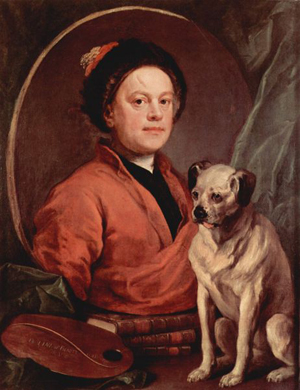William Hogarth painted his Self-Portrait with Palette in 1735, the year in which he also co-founded The Sublime Society of Beefsteaks, a gentlemen’s club dedicated to the celebration of British beef and liberty. Thirty-eight years old, quivering with energy and nervy arrogance, he looks like a man running late for his dinner. The artist’s powdered wig is a cascade of curls done in coils of grey and lead-white pigment applied to the canvas with such rapidity they resemble dabbed whirls of shaving foam. His neckerchief is a slurry of dirty snow, his coat a scumbled hint, the back wall of the room a patchy void. The palette that he holds with an invisible hand is a disc of dark wood, spotted with four blurred circles of flesh-coloured paint. Hogarth himself is a vivid blur of a human being, wheeling through space to face the mirror with a gaze of keen self-inquisition. He looks optimistic and insouciant but there is something else in his expression too – a barely suppressed sense of disenchantment.
“Hogarth”, a dizzyingly compendious exhibition of the artist’s work at Tate


